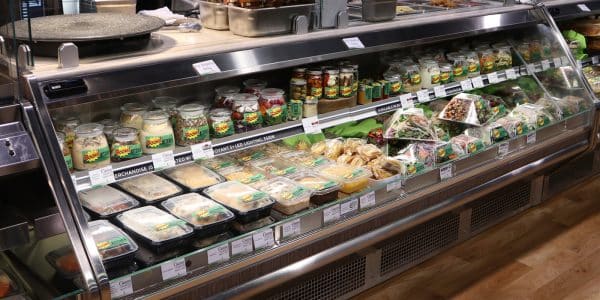Grab-and-Go Packaging – Convenience is King

As busy lives get busier, more consumers are moving away from traditional meal times and toward unscheduled snacking that can occur at any time of day. They’re increasingly interested in snacks with the same high level of quality and freshness they expect from other prepared foods, and that creates opportunities for retailers.
Fresh packaged snacks are a space where restaurants and convenience stores can’t easily compete. A snack program can be expanded with limited space, and repackaging existing food offerings in snack portions can build on your existing processes. Value can be added to simple snacks using fresh ingredients or additional flavors.
Supermarket News recently reported on the “salad toppers” offered by Roche Bros., a 20-store chain based in Wellesley, Mass. These small containers of shrimp, chicken, steak tips, hard-boiled eggs and other proteins sell for about $2.50 to $3.00 and can also be eaten as standalone snacks. The company also sells charcuterie snack plates for one or two people featuring sliced meats such as prosciutto with bite-sized cheese pieces and pickled vegetables. Another creative choice comes from Libbie Market in Richmond, Va., which offers tuna and chicken salads in two- to three-ounce containers.
The fundamental element of snack packaging is, obviously, portability. “Forty-two percent of Americans say that portability is the convenience-related feature they prioritize the most when they are choosing food and drink products to consume while traveling,” says Tom Vierhile, innovation insights director at research firm Canadean, which provides industry analysis on international food and beverage trends. However, Bryce Rutter, CEO of Metaphase Design Group, sees much room for improvement, as growth in the category creates opportunities to combine innovations.
Rutter believes that consumers will be seeking out packaging that is environmentally conscious, ergonomically friendly, and engaging as a complementary aspect of the snacking experience. Consumer willingness to wrestle with packaging that is difficult to open or reseal will rapidly decrease as their options expand. If you’re on the move, you may not have a random sharp implement close at hand to carve a short cut through a nonintuitive package design.
It certainly seems logical to pursue ways of eliminating the need for utensils generally in this category. If consumers aren’t driving while they’re eating, that other hand is probably holding a device. Vierhile points to a recent development that combines that convenience with another priority for snackers, easy portion control. A ready-to-eat popcorn product called Poptacular comes in a “bag… shaped somewhat like a funnel… openable (and resealable) at both ends. Opening the top of the bag allows the consumer to eat a pre-measured portion of popcorn…. Opening the bag from the bottom allows access to the entire bag.”
Rutter cites pulp-based designs as sturdy options that can provide sensory inputs that subtly enhance the snacking experience. For example, the texture of pulp will feel very different from plastic as a consumer opens a package and produce a different sound. While plastic might offer, for example, a clear view of a package’s contents, pulp might be a better choice for certain foods.
Dr. Keith Vorst, director for the Polymer and Food Protection Consortium at Iowa State University, emphasizes that retailers, as the customers of packaging manufacturers, are every bit as entitled as their own customers to shop elsewhere if their needs aren’t being met. Retailers are not obligated to accept what’s offered to them but should feel free to work with their suppliers to obtain packaging that will not only address traditional concerns about temperature and food safety but also allow them to customize their snacking options.
Sales might be increased even more by tracking customer behavior and rotating snack offerings throughout the day. Relaxing of traditional associations between certain foods and specific times of day are part of the definition of this trend, but retailers could still benefit from considering whether certain items are more daypart-sensitive and rearranging accordingly.